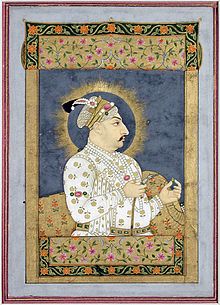
Back ناصر الدين محمد شاه Arabic ناصر الدين محمد شاه ARZ Məhəmməd Şah (Moğol) Azerbaijani محمد شاه قورکانی AZB मुहम्मद शाह Bihari মুহাম্মদ শাহ Bengali/Bangla Muhàmmad Xah de Delhi Catalan محەمەد شا گۆڕکانی CKB Muhammad Shah German Μουχαμάντ Σαχ Greek
| Muhammad Shah | |||||||||
|---|---|---|---|---|---|---|---|---|---|
| Padishah Al-Sultan Al-Azam | |||||||||
 Emperor Muhammad Shah holding an emerald and a mouthpiece of a huqqa, by Nidha Mal, c. 1730 | |||||||||
| Emperor of Hindustan | |||||||||
| Reign | 27 September 1719 – 26 April 1748 | ||||||||
| Coronation | 29 September 1719 | ||||||||
| Predecessor | Shah Jahan II Jahangir II (titular) | ||||||||
| Successor | Ahmad Shah Bahadur | ||||||||
| Wazirs |
| ||||||||
| Born | Roshan Akhtar[1] 7 August 1702 Ghazni, Kabul Subah, Mughal Empire | ||||||||
| Died | 26 April 1748 (aged 45) Delhi, Mughal Empire | ||||||||
| Burial | Mausoleum of Muhammad Shah, Nizamuddin Dargah, Delhi, India | ||||||||
| Consort | |||||||||
| Wives |
| ||||||||
| Issue |
| ||||||||
| |||||||||
| House | House of Babur | ||||||||
| Dynasty | Timurid dynasty | ||||||||
| Father | Jahan Shah | ||||||||
| Mother | Fakhr-un-Nissa Begum[2] | ||||||||
| Religion | Sunni Islam (Hanafi) | ||||||||
| Seal |  | ||||||||
| Mughal emperors | ||||||||||||||||||||||||||||||||||||||||||||||
|---|---|---|---|---|---|---|---|---|---|---|---|---|---|---|---|---|---|---|---|---|---|---|---|---|---|---|---|---|---|---|---|---|---|---|---|---|---|---|---|---|---|---|---|---|---|---|
|
||||||||||||||||||||||||||||||||||||||||||||||
Mirza Nasir-ud-Din Muḥammad Shah (born Roshan Akhtar;[1] 7 August 1702 – 26 April 1748)[1] was the thirteenth Mughal emperor from 1719 to 1748.[4] He was son of Khujista Akhtar, the fourth son of Bahadur Shah I. After being chosen by the Sayyid Brothers of Barha, he ascended the throne at the young age of 16, under their strict supervision.[5]
He later got rid of them with the help of Nizam-ul-Mulk, Asaf Jah I – Syed Hussain Ali Khan was murdered at Fatehpur Sikri in 1720 and Sayyid Hassan Ali Khan Barha was captured in battle in 1720 and fatally poisoned in 1722.[6] Muhammad Shah was a great patron of the arts, including musical, cultural and administrative developments, he is thus often referred to as Muhammad Shah Rangila (lit. 'Muhammad Shah "the colourful"').[7] His pen-name was "Sadrang" and he is also sometimes referred to as "Bahadur Shah Rangila" after his grand father Bahadur Shah I.
Muhammad Shah's reign was marked by rapid and irreversible decline of the Mughal Empire that was exacerbated by Nader Shah's invasion of India and the sacking of Delhi in 1739. The course of events not only shocked and mortified the Mughals themselves, but also other foreigners, including the British.
- ^ a b c "Muhammad Shah". Encyclopædia Britannica. Retrieved 18 September 2017.
- ^ a b c d e f Malik, Zahir Uddin (1977). The reign of Muhammad Shah, 1719–1748. London: Asia Pub. House. p. 407. ISBN 9780210405987.
- ^ William Irvine. Later Mughals: 1719–1739, Volume 2. p. 271.
- ^ Sen, Sailendra (2013). A Textbook of Medieval Indian History. Primus Books. p. 193. ISBN 978-9-38060-734-4.
- ^ Krishna (2022). The Wonder That Is Urdu. Motilal Banarsidass. p. 121. ISBN 9788120843011.
- ^ Shaharyar M. Khan (2000). The Begums of Bhopal (illustrated ed.). I.B.Tauris. p. 18. ISBN 978-1-86064-528-0.
- ^ Cite error: The named reference
snwas invoked but never defined (see the help page).